Electricity is one of the main types of energy used in EAFs’ steelmaking, and plenty of electrical energy is consumed every day.Demand for electricity power is not a very steady state, and there are on-peak, mid-peak and off-peak periods in a day.In order to deal with the uneven electricity demand, many countries in the world adopt the time-of-use (TOU)tariffs.Decreasing energy consumption and reducing energy costs can be quite different under TOU tariffs[1].The changing price makes many producers take on more production in off-peak hours instead of on-peak hours in response to the price fluctuation and to avoid additional electricity costs.The existence and development of TOU tariffs propose a higher requirement for electric arc furnaces’ (EAFs)scheduling than before.
In addition, the EAFs’ steelmaking system is a complex dynamic open system.The performance degradation of EAFs may cause interruption during processing, even force the entire manufacturing system to shut down.Most of the current literature related to scheduling problems assumes that the machines are continuously available during the plan horizon.However, the machines may not be available for preventive maintenance, periodic repairs, or breakdowns in real production[2].
This paper mainly focuses on the effects of the piece-rate maintenance and TOU tariffs on EAF steelmaking.There is much research on machine maintenance[3-6].However, most of it mainly investigated periodic maintenance scheduling problems or preventive maintenance scheduling problems.Furthermore, Yu et al.[7] proposed a significant concept of piece-rate machine maintenance and proved that the single-machine scheduling problems with two synergetic agents and piece-rate maintenance were all polynomial solvable.Xue et al.[8] studied the single-machine scheduling problem with piece-rate machine maintenance and interval constrained actual processing time.
The impact of electricity costs on scheduling has been studied by some researchers.To reduce energy consumption, some researchers have investigated the single-machine scheduling problem in manufacturing systems[9-11].The TOU electricity pricing encourages manufacturers to shift their electricity usage from on-peak periods to off-peak periods.Liu et al.[12] studied the optimal scheduling under the policy of TOU tariffs.Ding et al.[13] studied the unrelated parallel machine scheduling problem under a TOU tariff scheme and proposed two methods to solve the problem.Che et al.[14] studied the energy-conscious single-machine scheduling problem under TOU or time-dependent electricity tariffs.Moon et al.[15] dealt with the machine-dependent electricity costs and the energy efficiency of the unrelated parallel machine scheduling problem.Sharma et al.[16] built a new econological scheduling model combining the economic and ecological aspects of a multi-part multi-machine setup operating under TOU tariffs.Tan et al.[17] studied the steelmaking-refining-continuous casting scheduling problem while considering variable electricity prices.
From the above literature review, it can be found that the studies of the machine scheduling problem under machine maintenance mainly focused on preventive maintenance.Besides, the scheduling problems under TOU tariffs mainly investigated the influence of the variable electricity price on the pre-determined processing sequence of jobs, without considering the fact that the machines could not be available all the time.This paper examines the EAF steelmaking scheduling problem under TOU tariffs and piece-rate machine maintenance to minimize the total electricity cost and makespan.A joint optimization schedule model of EAF steelmaking with piece-rate machine maintenance and TOU tariffs is developed.An innovative algorithm based on the longest processing time algorithm (LPT)and genetic algorithm (GA)is proposed.It is called the LPT-gene algorithm.The charges are inserted into the available time periods one after another in a non-increasing order of their electricity consumption rates and each charge is inserted into the periods with minimum electricity cost.
1 Scheduling Problem
The scheduling problem in this study can be described mathematically as follows.There is a set of charges N={1,2,…,i,…,n}, and every charge can be processed on each EAF.There is a set of EAFs M={1,2,…,j,…,m}, and the EAFs need to be maintained once when every s charges are finished, i.e.piece-rate maintenance[8], and the maintaining time is t.pij denotes the normal processing time of charge i on machine j.Due to the fatigue effect of the EAF, the actual processing time of charge i on EAF j is an increasing function of the normal processing time of pij.Similar to Xue et al.[8], we also suppose that the actual processing time ![]() is a functional with the variables of the initial processing time pij and the position rij in a sequence.The equation is described as follows:
is a functional with the variables of the initial processing time pij and the position rij in a sequence.The equation is described as follows: ![]() There is also a finite and discrete set of time T={1,2,…,T}.Without loss of generality, we suppose that the EAFs are out of operation during the maintenance.The actual processing time of each charge has a correlation with the EAF’s fatigue effect and the position in a processing sequence.Moreover, the continuous changes in electricity prices have become an important factor in defining energy consumption costs.Therefore, two main factors, which are electricity-price fluctuation and piece-rate maintenance, should be taken into account in the EAF steelmaking scheduling.
There is also a finite and discrete set of time T={1,2,…,T}.Without loss of generality, we suppose that the EAFs are out of operation during the maintenance.The actual processing time of each charge has a correlation with the EAF’s fatigue effect and the position in a processing sequence.Moreover, the continuous changes in electricity prices have become an important factor in defining energy consumption costs.Therefore, two main factors, which are electricity-price fluctuation and piece-rate maintenance, should be taken into account in the EAF steelmaking scheduling.
The assumptions are adopted as follows:
1)The EAFs are considered parallel and independent.
2)The charges are considered independent.
3)The processing time is known in advance.
4)The scheduling is affected by the EAF’s fatigue effect.
5)After the implementation of piece-rate maintenance, the EAF is restored to its initial state.
6)Once a charge has begun to be processed, it cannot be interrupted.
Using the classic scheduling scheme for scheduling problems, the problem is described as follows:
(1)
where Rm denotes the EAF m which has different efficiency; OPRM denotes the piece-rate maintenance; Ci denotes the completion time of EAF i; Cmax=max{Ci|i=1,2,…,n}, which is makespan; Ce denotes the electricity costs; w is the weight of the electricity cost.
With the notations given above, the mixed-integer linear programming (MILP)model is proposed to minimize makespan and the electricity cost.
minΦ=Cmax+wCe
(2)
Subject to
![]()
i=1,2,…,n;j=1,2,…,m;k=1,2,…,T
(3)
where xijk=1 means that charge i is processed on EAF j during period k, otherwise xijk=0; yij=1 denotes that charge i is assigned to EAF j, otherwise yij=0.
rij=kij-sL i=1,2,…,n;j=1,2,…,m
(4)
where rij denotes charge i is scheduled in the r-th position of the EAF j; kij denotes the starting time of charge i processed on EAF j; Gj denotes the group of the charges assigned to EAF j.L is the maintenance frequency, which is equal to the integer part of [Gj/s].
![]()
i=1,2,…,n;j=1,2,…,m
(5)
![]()
i=1,2,…,n;j=1,2,…,m
(6)
![]()
i=1,2,…,n;j=1,2,…,m;k=1,2,…,T
(7)
![]()
i=1,2,…,n;j=1,2,…,m;k=1,2,…,T
(8)
where ek denotes the TOU tariffs price during k period; ![]() indicates the power consumption of the EAF during processing;
indicates the power consumption of the EAF during processing; ![]() denotes the power consumption of the EAF during maintenance; zj=1 denotes that EAF j is under maintenance, and zj=1-xijk, otherwise zj=0.
denotes the power consumption of the EAF during maintenance; zj=1 denotes that EAF j is under maintenance, and zj=1-xijk, otherwise zj=0.
(9)
(10)
![]()
i=1,2,…,n;j=1,2,…,m
(11)
where Z is a large number.
![]()
i=1,2,…,n;j=1,2,…,m
(12)
θi∈{0,1}
(13)
Constraint (3)shows the relationship of the actual processing time and the decision variables.Constraint (4)shows the position of the charge when the EAF is implemented maintenance.Constraint (5)is the starting time of each charge.Constraint (6)shows that the actual processing time of the charge is related to the EAF and the processing position in a sequence.Constraint (7)ensures that the least completion time of the last charge is greater than the completion time of any one of the charges.Constraint (8)is the total power consumption cost.Constraint (9)ensures that each charge has been assigned to operate on one EAF.Constraint (10)denotes that the sum of the charges processed on EAFs equals the total number of the charges.Constraints (11)and (12)guarantee that one charge can be processed on the EAF at the same time.Constraint (13)is a binary variable.
Proposition 1 The scheduling problem ![]() OPRM|Cmax+wCe is NP-hard.
OPRM|Cmax+wCe is NP-hard.
Proof When the number of the machines is m=2 and the execution time of the charge does not change with the processing position, the optimal problem is equivalent to the most special parallel machine scheduling ![]() McKay et al.[18] pointed out the parallel machine scheduling problem with the objective of minimizing total completion times; i.e.
McKay et al.[18] pointed out the parallel machine scheduling problem with the objective of minimizing total completion times; i.e.![]() is NP-hard.Therefore, the scheduling problem
is NP-hard.Therefore, the scheduling problem ![]() is NP-hard.
is NP-hard.
2 Algorithm Design
In this study, an innovative algorithm based on the LPT algorithm and GA is proposed to seek the optimal solution, which is more effective because it considers the actual processing time.According to the LPT algorithm, we shall, as much as possible, prioritize the charges which have longer processing time.Next, considering the TOU tariffs, some operations may be assigned to a lower electricity price period without affecting the completion time.This approach provides an opportunity to minimize makespan and the total electricity costs under the situation of the piece-rate maintenance and TOU tariffs.
The LPT-Gene algorithm is described in detail.First, an initial population is created.Chromosomes are initialized utilizing real-number encoding.By exploiting the properties of the problem, a multi-layer encoding scheme is designed.Each layer of encoding expresses different meanings and all of them are together composed of the solution.Thus, a chromosome corresponds to solution of the complicated problem accurately.The fitness measure is the objective function.The roulette selection mechanism is used to select two parents, and the one-point crossover mechanism is employed to the selected parents.The newly created chromosomes are compared and replaced, and then form a new set of parents.The best solution of the problem is observed for the fixed consecutive generations, if there is no improvement.
3 Computational Experiments
In this section, some computational experiments are designed to further explore the effects of TOU tariffs and piece-rate maintenance.The scheduling of some charges in five parallel EAFs’, on a time units’ horizon, are examined.The EAF has to be maintained once when every two charges are completed, and the maintenance activity will promote machine efficiency.The maintenance time is set to be 60 min.The operating power consumptions of the EAFs are 600, 550, 600, 550, 650 kW·h, and the maintenance power consumptions of the EAFs’ maintenance are 20, 10, 20, 10, 30 kW·h.The time points in one day of TOU tariffs are set to be 0, 8, 12, 21, and the electricity prices in every period are set to be 0.4, 1.2, 0.8, 1.2, 0.8 Yuan.The initial population size is 100, and the evolutionary generations is 50.The generational gap is 0.9.The probability alternating and mutant probability are 0.8 and 0.6, respectively.We randomly generate a processing time range of 45 and 60 min.For simplicity, the actual processing time is defined as ![]() The same experiments are conducted.The first computational experiment examines the impact of electricity cost on the makespan and the total power consumption cost, and then the comparison between the LPT-Gene algorithm and GA and the impacts of electricity price on the optimal solution are analyzed.Furthermore, the impacts of the variable weight and electricity price on the optimal solution are analyzed.Finally, the impacts of the weight and the variation of electricity price between the on-peak and off-peak periods are shown in the computational experiment.
The same experiments are conducted.The first computational experiment examines the impact of electricity cost on the makespan and the total power consumption cost, and then the comparison between the LPT-Gene algorithm and GA and the impacts of electricity price on the optimal solution are analyzed.Furthermore, the impacts of the variable weight and electricity price on the optimal solution are analyzed.Finally, the impacts of the weight and the variation of electricity price between the on-peak and off-peak periods are shown in the computational experiment.
3.1 Comparison of the optimization goal with electricity cost or without
The impacts of electricity cost on some experiments are studied in this section.Scenario 1 is introduced for conveniently describing the optimal goal that includes makespan and electricity cost.Scenario 2 only considers a single target, that is, makespan.Tab.1 shows the total electricity costs of the schedule and makespan solved by the LPT-gene algorithm.In Scenario 2, the average value of makespan is 9.2, and the corresponding electricity cost is 10 996; in Scenario 1, the minimum value is 8.47 and the corresponding electricity cost is 11 359.Comparing the average value of two scenarios, we can find that the makespan’s average value of Scenario 1 is greater than that of Scenario 2, while the average value of the electricity cost in Scenario 2 is much smaller than the average value of Scenario 1.The figures highlight that energy consumption cost needs to be considered in the manufacturing process, especially under the situation of reducing energy consuming in the whole world.Therefore, the consideration of makespan and electricity costs is more accordant with practical circumstances.Fig.1 provides a more intuitive way to describe the differences between the two scenarios.There is a large electricity cost difference between the two situations, in particular, steel companies care much more about the electricity cost due to the pressure of energy saving and pollution reduction.Minimizing makespan and the electricity cost simultaneously can lead to an outcome with lower energy consumption and a similar makespan.
Tab.1 Statistics of the optimal solution for two scenarios

StatisticsScenario1MakespanCeScenario2MakespanCeMean10.5111348.79.0111765.1Standarddeviation0.713144.480.23174.40Max11.32115989.3812027Min9.2109968.4711359

Fig.1 Comparison of the optimal solutions for two scenarios
3.2 Comparison between the LPT-gene algorithm and GA
Given charges 20, the LPT-gene algorithm and GA are designed to calculate makespan and electricity costs.Tab.2 shows the statistics of the optimal solutions by the LPT-gene algorithm and GA and Fig.2 shows the comparison results of optimal solutions for two different algorithms.Noted that by the LPT-gene algorithm, the mean value of makespan is 9.69, while by the GA, it is 10.21.The difference of makespan by the LPT-gene algorithm and GA is very small.Meanwhile, the mean value of optimal solutions solved using the LPT-gene algorithm is 11 261.5, and the other is 11 408.This data means that we can obtain not only better makespan but also an optimal solution using the LPT-gene algorithm.That is to say, the LPT-gene algorithm has better performance than the GA.

Fig.2 Comparison of the optimal solutions solving by the LPT-gene algorithm and GA
Tab.2 Statistics of the optimal solutions solving by the LPT-gene algorithm and GA

StatisticsLPT⁃genealgorithmMakespanCeOptimalsolutionGAMakespanCeOptimalsolutionMin8.691086810878.8410.911099311001.94Max10.961157211581.1811.051154211552.94Mean9.6911261.511271.1910.2111257.6511408Standarddeviation0.86178.32178.100.88191.88192.01
3.3 Impact of processing power consumption
In this section, four scenarios are designed to study the impacts of processing electricity consumption and the EAF maintenance electricity consumption.In Scenario 1, we suppose that the difference in the processing power consumption obviously increases, but the power consumption during EAF maintenance remains the same.In Scenario 2, the processing power consumption remains the same, while the differences of the processing power consumption obviously increases.In Scenario 3, we consider the opposite of Scenario 1.In contrast to Scenario 2, we observe that the differences of power consumption decrease in Scenario 4.
Tab.3 shows that the average values of makespan in four scenarios are 10.61, 10.29, 10.08 and 9.92, respectively, and the average values of the optimal solutions in four scenarios are 131.22, 124.38, 131.02 and 134.87, respectively.These figures indicate that when the difference of the processing power consumption increases, makespan and the optimal solutions will increase.At the same time, makespan is almost unaffected by the variation of piece-rate machine maintenance, while the optimal solutions in Scenario 3 are obviously affected by the variation of the processing power consumption.According to Fig.3, the processing power consumption of the EAF has more influence on the optimal solution than the power consumption of the piece-rate machine maintenance.
Tab.3 Statistics of the optimal solution with the variable processing power consumption

StatisticsScenario1MakespanSolutionScenario2MakespanSolutionScenario3MakespanSolutionScenario4MakespanSolutionMin8.999.90268.92110198.8107158.2110982Max11.291086911.281167211.381140111.1511680Mean10.6110320.310.2911387.310.0811045.99.9211274.4
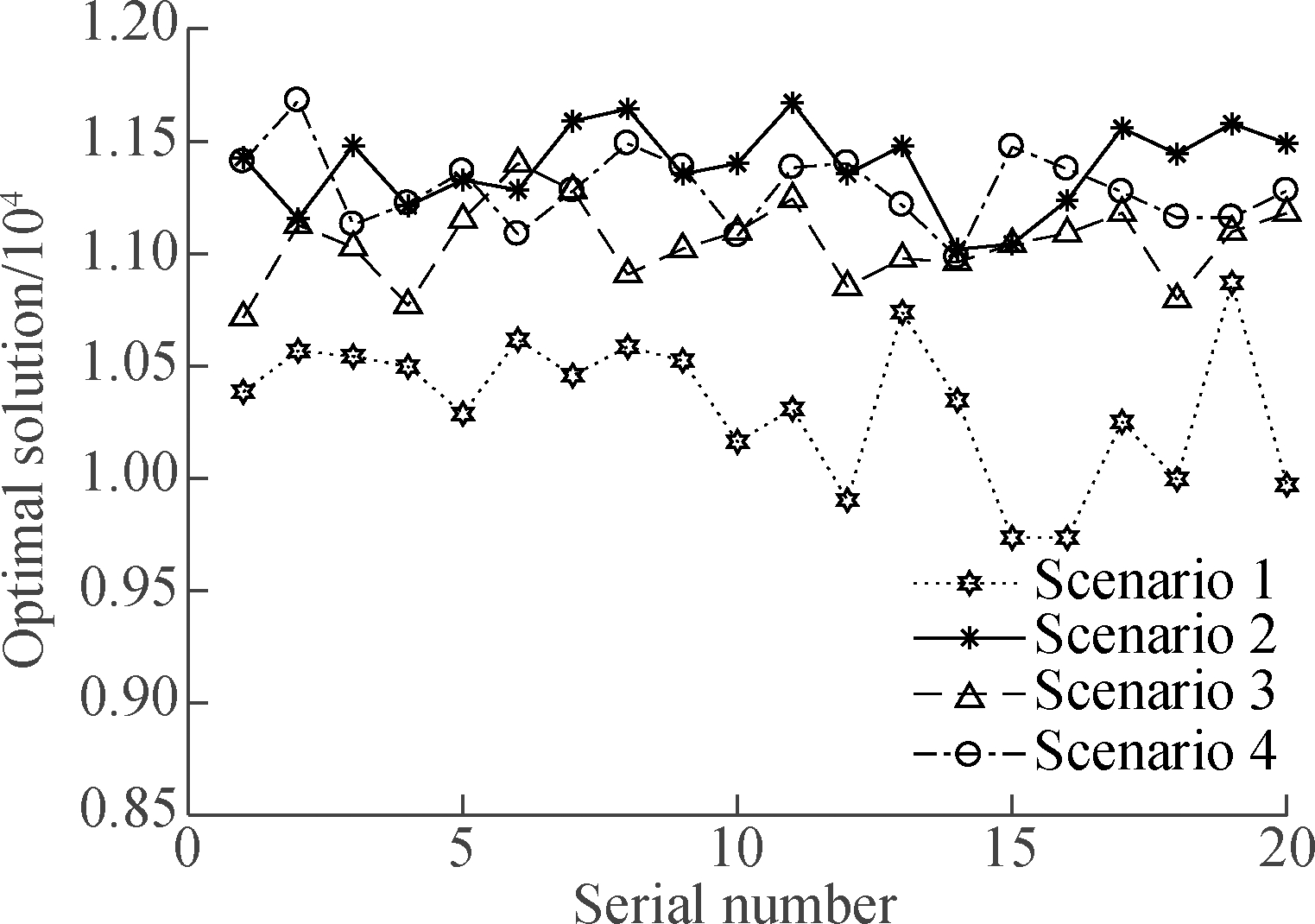
(a)

(b)
Fig.3 The impact of the variable processing power consumption.(a)Optimal solutions; (b)Makespan
3.4 Impact of electricity price
In this experiment, the impact of the difference between the peak and valley electricity prices on the optimal solutions is studied.The electricity prices are set to be 0.4, 2.4, 0.8, 2.4, 0.8, respectively.
Fig.4 shows the variation trend of makespan is similar to the optimal solution, although it is not quite the same.The computational experiments demonstrate that it is the most effective way to raise the gap between the peak and valley prices to save energy consumption.In most cases, however, they show the same trend.The main reason is the application of the intelligent algorithm.

Fig.4 The impact of the variable electricity price
3.5 Impact of variable weight
We define two new measures to assess the relationship between the makespan and the electricity cost, and they are defined as W1=pCmax+wCe and W2=pCmax, respectively.The range of the weight is from 0.1 to 1.The makespan is transformed into the cost which is standardized by using the electricity cost.The unit processing cost of is set as 0 to 200.There are three analytical frameworks.The parameters are as follows:{p=[0,200],w=0.1; p=100, w=[0,1]},{p=[0,200], w=0.5; p=200, w=[0,1]}, and {p=[0,200], w=0.9; p=300, w=[0,1]}.The solution with the variable value p and the variation of the solution with the variable value w are shown in Fig.5.
It can be seen from Fig.5(a)that when p<120, the optimal values of W1 are less than those of W2; when p>120, they are the opposite in the vast majority of optimal values.In Fig.5(b), the parameter w is changed while keeping all the others at their default values.Fig.5(b)shows that the optimal solutions of W2 are comparatively close to the values of W1 when p=200.Fig.5(c)shows that when p=[0,160], there is little difference between the two optimal solutions; and when p>160, the difference between the two optimal values increases with the value of p.In Fig.5(e), with the weight of the electricity cost increasing, the optimal values of W1 are greater than the ones of W2.Figs.5(d)and (f)show the optimal solutions when the processing cost p=100 and p=300.The results show that when the processing cost is large while the weight of the electricity cost is small, the electricity cost has little influence on the decision policy.The decision makers often face conflicting objectives such as date of delivery and production cost while making operation decisions.Therefore, the integrative optimization is reasonable under the constraint of energy saving policies, and the company can find a trade-off between the makespan and the electricity cost.
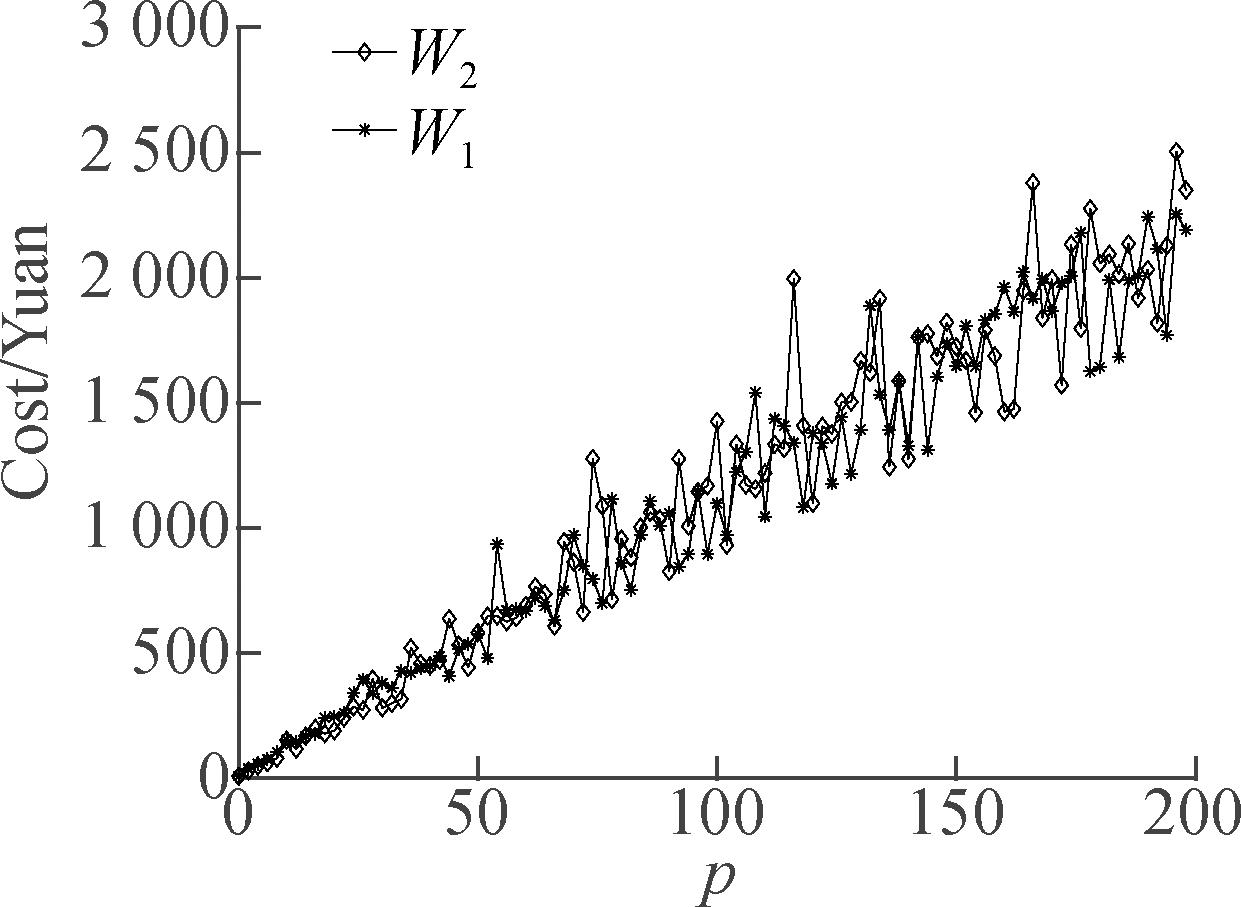
(a)
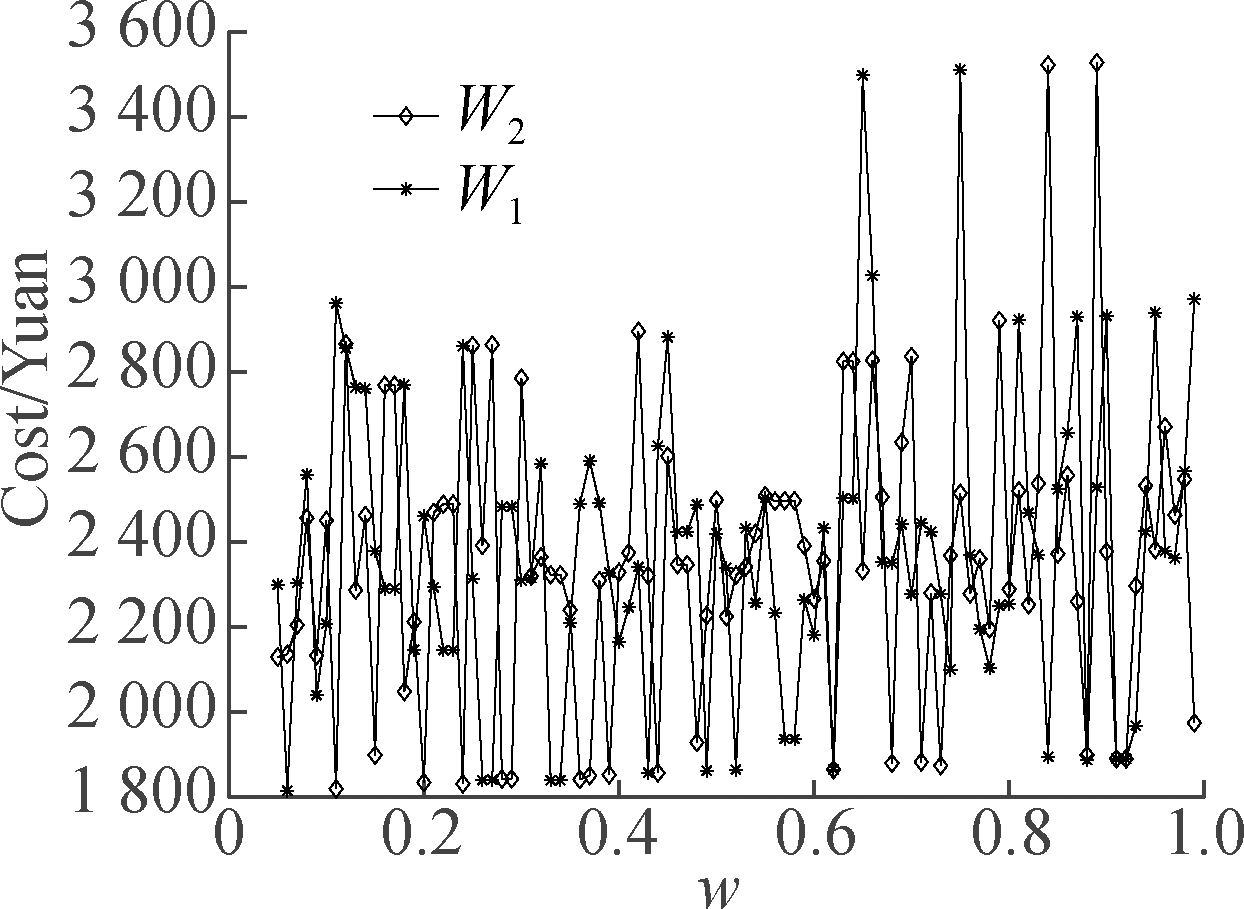
(b)
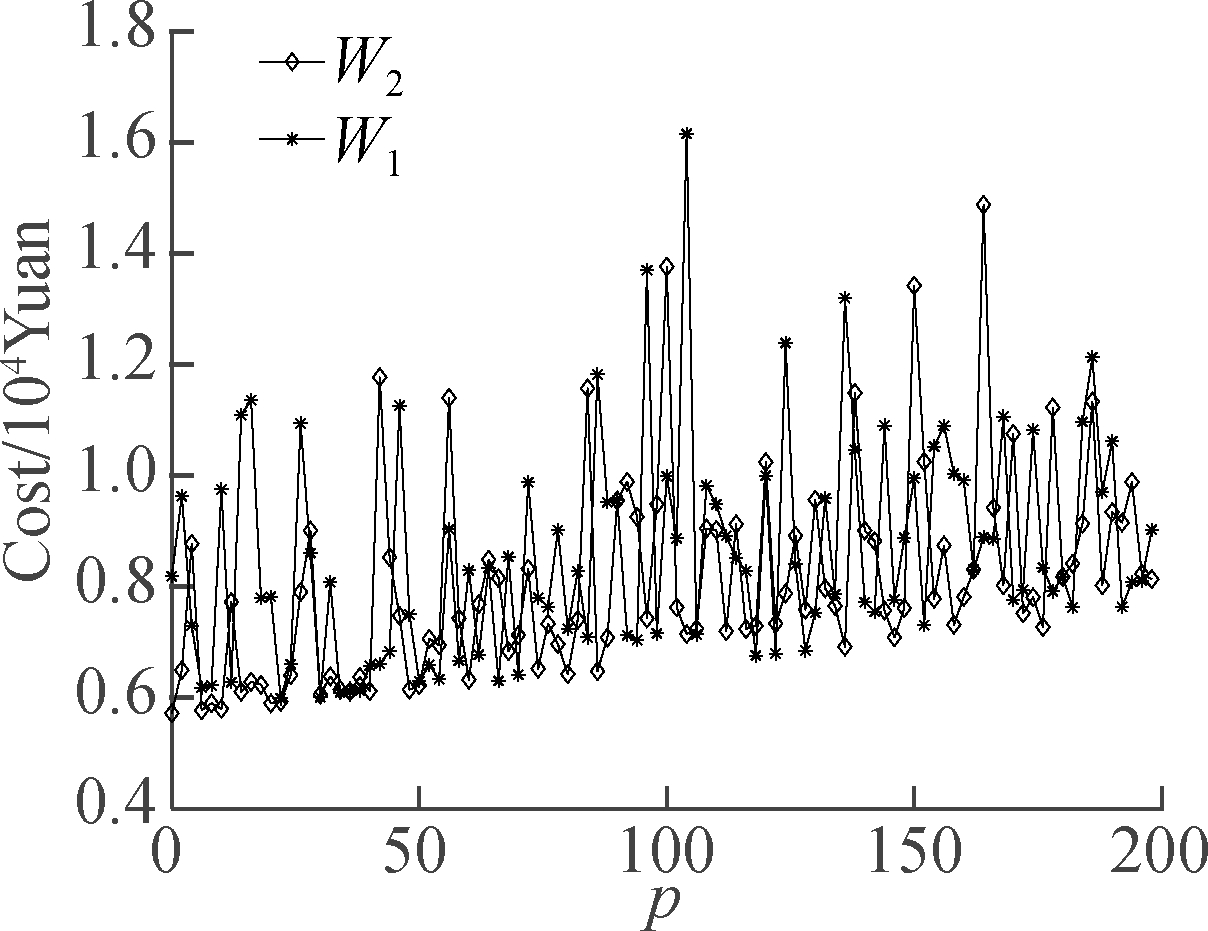
(c)

(d)

(e)

(f)
Fig.5 Impact of the variable value p and w on optimal solution.(a)p=[0,200], w=0.1; (b)p=100, w=[0,1]; (c)p=[0,200], w=0.5; (d)p=200, w=[0,1]; (e)p=[0,200], w=0.9; (f)p=300, w=[0,1]
3.6 Impact of the weight and variation of electricity price
In this experiment, the impacts of the different weights and variations of the electricity price are analyzed.The weight is set to be 0.1, 0.3, 0.5, 0.8, respectively, and the variations of the electricity price are set to be 0.8, 1, 1.2, 1.4, 1.6, respectively.All other parameters are kept at their default values.Fig.6(a)and Fig.6(b)show the three-dimension curved surface of makespan and the optimal solution with the parameters mentioned above.Fig.6(a)shows that when the weight keeps an invariable value, the values of makespan do not increase with the variation of the electricity price.Conversely, when the variation of the electricity price keeps an invariable value, there is no marked relationship between makespan and the weight.Fig.6(b)shows that the optimal solutions increase with the weight when the variation of the electricity price shows no change.In addition, a result similar to the above conclusion is obtained when the electricity price during peak load period gradually increases while the weight keeps the same.From the analysis, it is easy to conclude that the effect of the variation of the electricity price on the scheduling problem is greater than the weight.The trade-off between makespan and electricity cost has generated great economic and environment benefits for many steel enterprises.The simulation results indicate that significant savings may be achieved when considering TOU tariffs in the EAF steelmaking schedule.
4 Conclusion
This paper investigated the EAF scheduling problem with TOU tariffs and piece-rate machine maintenance to minimize the electricity cost and makespan.First, the problem is proved to be NP-hard.Then, we propose the LPT-gene algorithm which is based on the GA and LPT algorithms, and compare the performance of the LPT-gene and GA using randomly generated instances.Finally, the impacts of the electricity price and different weights on the optimal solutions of the problem are analyzed.The computational experiments show that taking the energy consumption costs into account in production has little influence on makespan; the performance of the LPT-gene algorithm is better than GA; and significant reductions in energy costs can be achieved by avoiding high-energy price periods and reducing the machining energy consumption difference.Several limitations exist in our work.First, only an energy-conscious EAF scheduling problem is considered in this work.Secondly, the function of the actual processing time may not accommodate different operational modes for the machine.In our future research, the proposed problem can be extended to consider the continuous casting billet of the EAF schedule problem with carbon emissions.

(a)
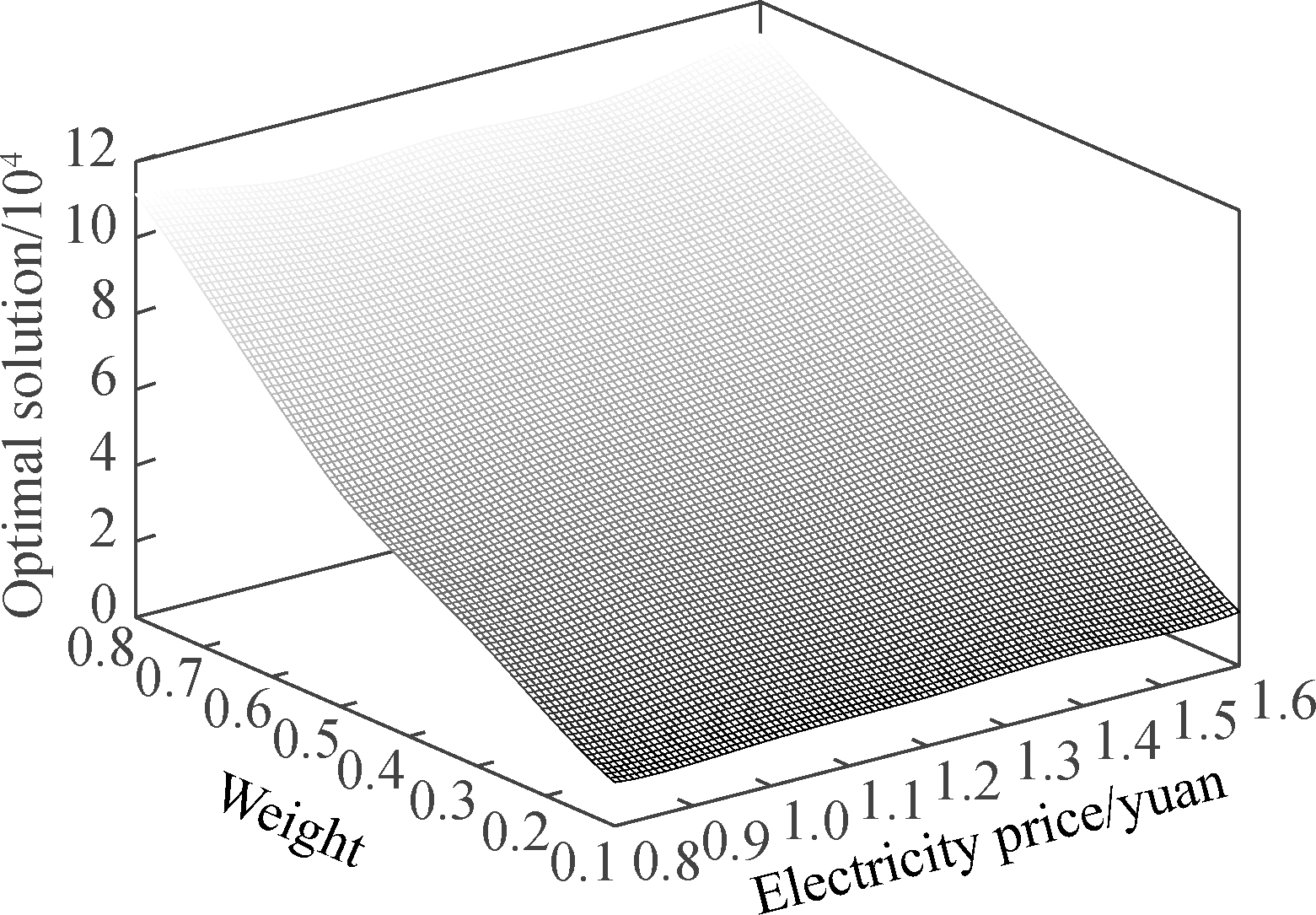
(b)
Fig.6 Impact of variable weights and difference electricity prices.(a)Makespan; (b)Optimal solution
References
[1]Fang K, Uhan N A, Zhao F, et al.Scheduling on a single machine under time-of-use electricity tariffs [J].Annals of Operations Research, 2016, 238(1/2): 199-227.DOI:10.1007/s10479-015-2003-5.
[2]Seidgar H, Zandieh M, Mahdavi I.Bi-objective optimization for integrating production and preventive maintenance scheduling in two-stage assembly flow shop problem [J].Journal of Industrial and Production Engineering, 2016, 33(6): 404-425.DOI:10.1080/21681015.2016.1173599.
[3]Wang S, Liu M.Two-machine flow shop scheduling integrated with preventive maintenance planning [J].International Journal of Systems Science, 2016, 47(3): 672-690.DOI:10.1080/00207721.2014.900137.
[4]Das Adhikary D, Bose G K, Jana D K, et al.Availability and cost-centered preventive maintenance scheduling of continuous operating series systems using multi-objective genetic algorithm: A case study [J].Quality Engineering, 2016, 28(3): 352-357.DOI:10.1080/08982112.2015.1086001.
[5]Nourelfath M, Fitouhi M C, Machani M.An integrated model for production and preventive maintenance planning in multi-state systems [J].IEEE Transactions on Reliability, 2010, 59(3): 496-506.DOI:10.1109/tr.2010.2056412.
[6]Liu B Y, Chen W D.Single-machine scheduling with preventive periodic maintenance and resumable jobs in remanufacturing system [J].Journal of Southeast University: English Edition, 2012, 28(3): 349-353.
[7]Yu X, Zhang Y, Xu D, et al.Single machine scheduling problem with two synergetic agents and piece-rate maintenance [J].Applied Mathematical Modelling, 2013, 37(3): 1390-1399.DOI:10.1016/j.apm.2012.04.009.
[8]Xue P, Zhang Y, Yu X.Single-machine scheduling with piece-rate maintenance and interval constrained position-dependent processing times [J].Applied Mathematics and Computation, 2014, 226: 415-422.DOI:10.1016/j.amc.2013.10.034.
[9]Shrouf F, Ordieres-Meré J, García-S nchez A, et al.Optimizing the production scheduling of a single machine to minimize total energy consumption costs [J].Journal of Cleaner Production, 2014, 67: 197-207.DOI:10.1016/j.jclepro.2013.12.024.
nchez A, et al.Optimizing the production scheduling of a single machine to minimize total energy consumption costs [J].Journal of Cleaner Production, 2014, 67: 197-207.DOI:10.1016/j.jclepro.2013.12.024.
[10]Yildirim M B, Mouzon G.Single-machine sustainable production planning to minimize total energy consumption and total completion time using a multiple objective genetic algorithm [J].IEEE Transactions on Engineering Management, 2012, 59(4): 585-597.DOI:10.1109/tem.2011.2171055.
[11]Tan Y, Huang Y, Liu S.Two-stage mathematical programming approach for steelmaking process scheduling under variable electricity price [J].Journal of Iron and Steel Research, International, 2013, 20(7): 1-8.DOI:10.1016/s1006-706x(13)60118-1.
[12]Liu C H, Huang D H.Reduction of power consumption and carbon footprints by applying multi-objective optimisation via genetic algorithms [J].International Journal of Production Research, 2014, 52(2): 337-352.DOI:10.1080/00207543.2013.825740.
[13]Ding J Y, Song S, Zhang R, et al.Parallel machine scheduling under time-of-use electricity prices: New models and optimization approaches [J].IEEE Transactions on Automation Science and Engineering, 2016, 13(2): 1138-1154.DOI:10.1109/tase.2015.2495328.
[14]Che A, Zeng Y, Lyu K.An efficient greedy insertion heuristic for energy-conscious single machine scheduling problem under time-of-use electricity tariffs [J].Journal of Cleaner Production, 2016, 129: 565-577.DOI:10.1016/j.jclepro.2016.03.150.
[15]Moon J Y, Shin K, Park J.Optimization of production scheduling with time-dependent and machine-dependent electricity cost for industrial energy efficiency [J].The International Journal of Advanced Manufacturing Technology, 2013, 68(1/2/3/4): 523-535.DOI: 10.1007/s00170-013-4749-8.
[16]Sharma A, Zhao F, Sutherland J W.Econological scheduling of a manufacturing enterprise operating under a time-of-use electricity tariff [J].Journal of Cleaner Production, 2015, 108: 256-270.DOI: 10.1016/j.jclepro.2015.06.002.
[17]Tan Y Y, Liu S X.Models and optimisation approaches for scheduling steelmaking-refining-continuous casting production under variable electricity price [J].International Journal of Production Research, 2014, 52(4): 1032-1049.DOI: 10.1080/00207543.2013.828179.
[18]McKay K, Pinedo M, Webster S.Practice-focused research issues for scheduling systems [J].Production and Operations Management, 2002, 11(2): 249-258.DOI: 10.1111/j.1937-5956.2002.tb00494.x.